|
|
|
Sort Order |
|
|
|
Items / Page
|
|
|
|
|
|
|
| Srl | Item |
| 1 |
ID:
134004
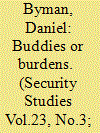

|
|
|
|
|
| Publication |
2014.
|
| Summary/Abstract |
Drawing on organization theory, this article argues that al Qaeda seeks affiliates to expand the scope and scale of its operations, gain the benefits of greater local expertise, better spread innovations, and?most important?endow itself and its mission with greater legitimacy. The conventional wisdom on al Qaeda affiliates emphasizes these benefits and thus paints affiliation as a tremendous boon to al Qaeda that magnifies the danger of terrorism. However, al Qaeda faces a host of problems related to delegation and integration, and often affiliation is a net loss. Divergent preferences and priorities, branding problems, shirking at the local level, adverse selection, and costly control mechanisms all make affiliates of questionable value to the core organization. Although the danger al Qaeda poses may have morphed with the core declining and the affiliates rising in importance, the broader movement is probably less dangerous than it was when the al Qaeda core was at its height. US counterterrorism often magnifies these integration problems and, if done well, can further induce friction, discredit the brand, and otherwise throw sand in the gears. The broader study of al Qaeda and its affiliates also offers insight into the study of organizations in general.
|
|
|
|
|
|
|
|
|
|
|
|
|
|
|
|
| 2 |
ID:
134008
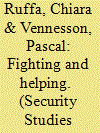

|
|
|
|
|
| Publication |
2014.
|
| Summary/Abstract |
In complex humanitarian emergencies, why are NGO-military relations cooperative in some cases, yet deeply conflictual in others? Drawing on historical-institutionalist theoretical insights, we argue that NGOs and military organizations are embedded in, and responding to, domestic institutional configurations that define a set of political incentives and constraints, material and normative, which structures and influences the characteristics and outcomes of their relations. Counterarguments suggest that organizational differences and the nature of their missions affect NGO-military relations. Using fresh empirical evidence we assess these arguments by comparing the Italian and the French experiences of NGO-military relations during the NATO-led International Security Assistance Force (ISAF) mission in Afghanistan and the UN mission in Lebanon (UNIFIL II) between 2007 and 2011.We find that domestic institutional configurations are not left behind when NGOs and military units deploy abroad. Rather, they shape NGOs' and militaries' capacity to work together instead of at cross purposes and ultimately influence the success of international action.
|
|
|
|
|
|
|
|
|
|
|
|
|
|
|
|
| 3 |
ID:
134007
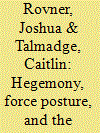

|
|
|
|
|
| Publication |
2014.
|
| Summary/Abstract |
International relations theories emphasize the stabilizing role hegemons play in world politics. But little scholarship has examined the link connecting hegemony to its potentially positive returns in the security realm: force posture. We correct this deficit by developing and testing an argument about the consequences of different hegemonic force postures under varying threat conditions. We present a typology of force posture options and probe their effects through over-time analysis of how major powers have worked to provide one particularly important public good since 1945: access to Persian Gulf oil. Drawing on field work, we also explore the implications of our framework for current and future US force posture in the region. We conclude that hegemonic stability is a very real phenomenon in the Gulf, but it does not require the massive forward deployment of US forces that has characterized the past twenty years of US presence there.
|
|
|
|
|
|
|
|
|
|
|
|
|
|
|
|
| 4 |
ID:
134006


|
|
|
|
|
| Publication |
2014.
|
| Summary/Abstract |
What explains the adoption of military innovations? In this article, we assess the empirical validity of adoption capacity theory by reconsidering one methodologically important case analyzed by Michael Horowitz: the diffusion of suicide terrorism. We show that, when addressing problems in Horowitz's research design, the case of suicide terrorism fails to support adoption capacity theory. We argue that, in order to account for the diffusion of this innovation, one needs to take into consideration the tactical incentives to overcome technologically superior enemies. The results of our quantitative and qualitative analyses suggest that terrorist groups fighting against very powerful states in terms of conventional capabilities are more likely to employ suicide attacks than those fighting against poorly equipped ones. Our findings are important because they provide systematic evidence in support of Kalyvas and Sànchez-Cuenca's argument that suicide terrorism is driven by tactical considerations and because they provide confidence in the external validity of Berman and Laitin's hardness of targets hypothesis. Our results also question Lyall and Wilson's finding that highly mechanized armies are inherently inadequate to win counterinsurgency operations. The superior conventional capabilities of a counterinsurgency army might in fact make traditional insurgent tactics ineffective and thus give insurgents an incentive to adopt suicide attacks.
|
|
|
|
|
|
|
|
|
|
|
|
|
|
|
|
| 5 |
ID:
134005
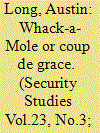

|
|
|
|
|
| Publication |
2014.
|
| Summary/Abstract |
Targeting the leadership of terrorist and insurgent groups has become a major component of US strategy since the attacks of September 11, 2001. Despite attracting modest scholarly attention, the conditions that increase or decrease the efficacy of leadership targeting remain unclear. A major limitation of current scholarly work is the lack of exploration of the internal organization of these groups and the relationship of that organization to leadership targeting effects. A close examination of leadership targeting of armed groups in Iraq and Afghanistan reveals that leadership targeting is highly effective against groups that are poorly institutionalized but has limited effects against well-institutionalized groups. This suggests that the level of resources devoted to leadership targeting should be inversely proportional to the level of institutionalization of the target.
|
|
|
|
|
|
|
|
|
|
|
|
|
|
|
|
| 6 |
ID:
134009
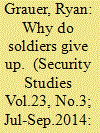

|
|
|
|
|
| Publication |
2014.
|
| Summary/Abstract |
Surrender, or capitulation to the adversary in combat, can have a significant impact on the duration, intensity, and outcomes of battles and wars. Yet the reasons why soldiers choose to capitulate are not well understood. This article advances a new theory of surrender that argues soldiers are most likely to surrender when they perceive proximate environmental signals leading them to expect humane treatment and a relatively short period of captivity and least likely to give up when those signals lead them to expect abusive treatment and lengthy imprisonment. The model is tested through a detailed examination of surrender rates in World War I and findings indicate that it explains more of the observed variation than do existing theories of capitulation. What little systematic data exists on surrenders during twentieth century interstate wars corroborates these findings. Implications for scholars and policymakers are briefly considered.
|
|
|
|
|
|
|
|
|
|
|
|
|
|
|
|
|
|
|
|
|